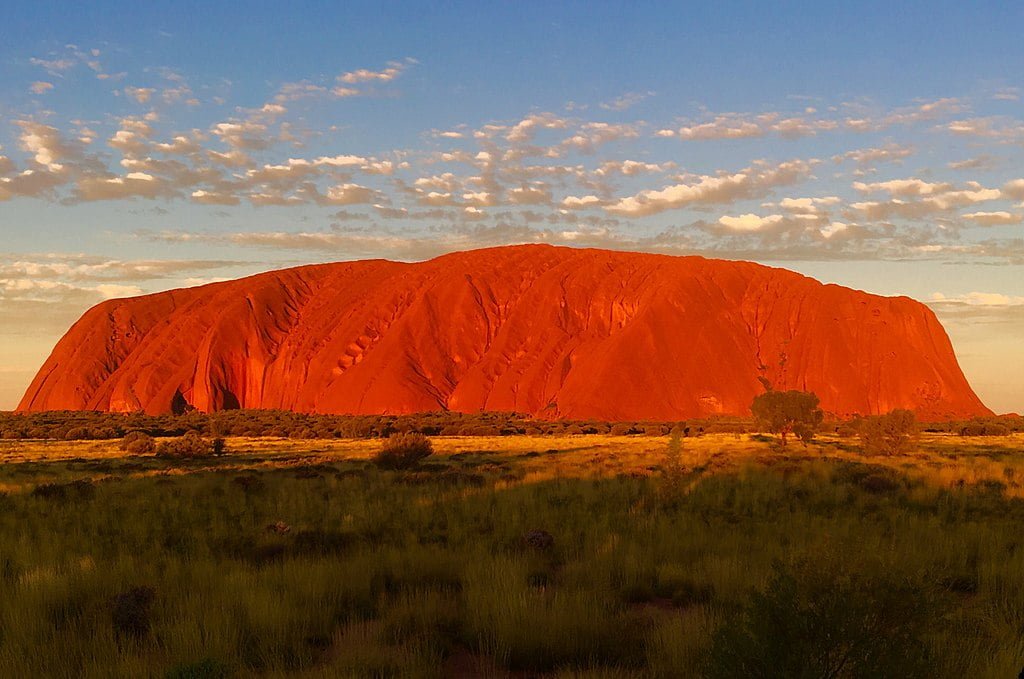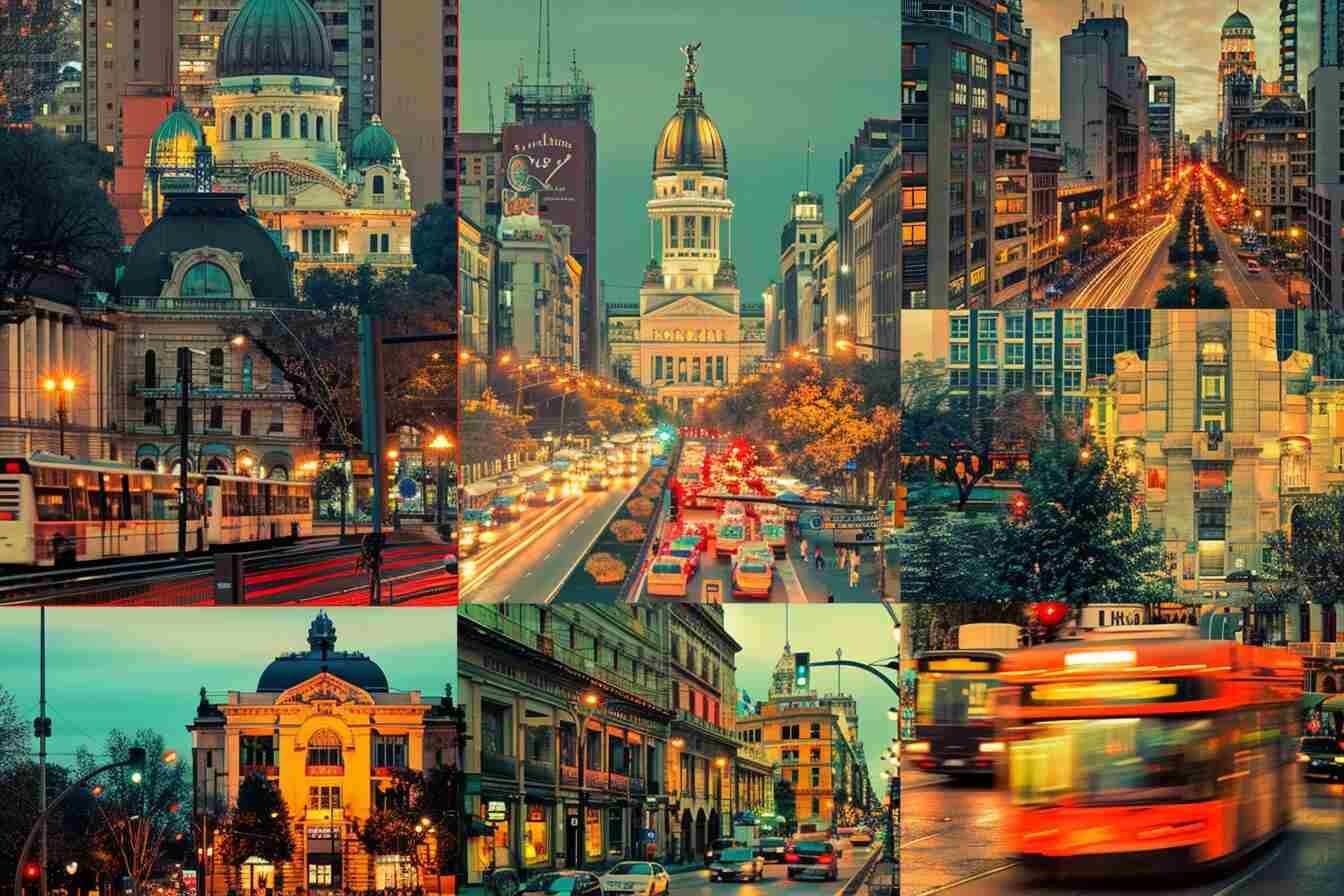Australia Travel Guide
A few landmarks in this Australia Travel Guide to prepare your trip to the huge island-continent. The city guide first. It is through them that you will arrive: Perth, in Western Australia, is the largest airport of entry into the country. It is the sunniest of the Australian capitals, its importance was born from the discovery of gold at the end of the 19th century. Melbourne is the most European of Australian cities, capital of fashion, cafés and concerts; between tropical forest and Great Barrier Reef, Cairns, ideally located to discover the riches of Northern Queensland.
At the other end of the state, the entry point is Brisbane, to leave for Fraser Island and the beaches of the Sunshine Coast or the Gold Coast. And, in the very south, Sydney, which alone is worth a stay. Nature of course, the Blues Mountains in New South Wales, Kakadu National Park in the Northern Territories, where the beauty of the landscapes rivals the richness of Aboriginal paintings, and the mythical Uluru (Ayers Rock). In South Australia, Kangaroo Island, where you can see seals, koalas, wild pigs, emus and kangaroos; in the state of Victoria, the Great Ocean Road and its spectacular panoramas; and Tasmania to see the devil (but also paddling wallabies, pademelons, echidnas, wombats, quolls, possums, dolphins…). It’s up to you to build your itinerary.
We have tried to present the country to you in a few words, taking up the main subjects that characterize Australia’s identity: climate, weather, geography, useful links to the tourist office website, and other practical information are offered.
We do not intend to make this Australia Travel Guide and these pages a complete “wiki” guide to Australia. However, you will find the majority of questions that our customers ask us before their departure.
What to visit in Australia
Australia is known for its southern cities which, like fortresses, guard the continent. On the east coast, in the territory of Queensland, starting from Cairns (starting point for unforgettable dives), Townsville, Mackey and Brisbane (the paradise of surfers), walk along the beach for a discovery of the Gold Coast, Sydney and Newcastle. Then go south to admire the Morningtone Peninsula and Melbourne and finally push to Adelaide or Perth in the West. And the capital? Yes, that’s Canberra, although the title could easily have been given to the majestic city of Sydney.
Gastronomic specialties in Australia
A flight to Australia immerses you in a universe of multiple flavors and renowned wines that can be tasted during the many gastronomic festivals. Taste wines in Swan Valley, Bondi, the Coal River or Barossa. Australia is also the homeland of Foster or Victoria Bitter blond beer, served in a jug (jug). As far as exotic fruits are concerned, there is something for everyone in hotels in Australia: papayas, coconuts, mangoes, lychees, pineapples… Real gourmands can even try the meat of kangaroo, crocodile, emu or buffalo. The local specialty par excellence is vegemite, a kind of salty spread. Let yourself be carried away by the smells of satay or even spicy noodles.
Art and culture in Australia
The main cultural point of Australia is definitely linked to its original inhabitants, the Aborigines, with their beliefs, dances and other typical habits and customs. Come and meet them thanks to the many museums and galleries (in particular, the national galleries Victoria or Australia). See also: Art Gallery of New South Wales (medieval objects from Asia), National University Classics Museum (ancient Greece), or Nicholson Museum (antiques from Australia). The cultural capital is undoubtedly Sydney. After its famous Opera, the other symbol of this Australian city is graffiti and Street Art in general. During the discovery of the continent, the arts are never absent. This country marries the new creative scene with classic immortals in all areas of culture.
When to go to Australia?
The best times to go to Australia…
Good news there is no wrong answer to the question “When to go to Australia?”. Australia is so large that the climate and weather are very different from one region to another. When the weather is nice in the north of the Australian territory, it was rather cold and the risk of rain is frequent in the south. On the other hand, when the heat and humidity are at their maximum in the north, the temperatures are pleasant and the weather is mild in the south. In addition, sporting and cultural events take place throughout the year.
Australia can therefore be visited all year round unless you absolutely want to visit a destination. So all you have to do is choose the best time to go to Australia and visit the chosen destination.
What is the best season to go to Australia?
You can travel to Australia all year round, provided you choose the best time for each region.
– Spring (September-November): this is the best season to visit almost all of Australia, especially during the months of September and October. But, from the end of October, the North is wetter and storms are not uncommon.
– Summer (December-February): This is the high tourist season for the southern part of Australia. The temperatures are quite high and very pleasant to visit the region during this period. The visit of Central and Northern Australia is to be thought about, due to extreme heat in the Outback and torrential rains in the North. That being said, you will observe very different landscapes.
– In autumn (March-May): temperatures are reasonable throughout Australia. This is a good time to discover the Outback and the Australian North as well as the southern regions.
– Winter (June-August): it is the ideal season to travel the North and the Center of the country (north of the Northern Territory, north of Western Australia, Queensland), without suffering from the heat. This is also the best time to explore the Great Barrier Reef.
On the other hand, it is not the ideal season to visit southern Australia: the weather is rainy, and the temperatures quite cool.
Cities in Australia
Adelaide (South)
On the coast, in the east of South Australia, Adelaide has a city center whose streets are drawn with a line. Surrounded by green spaces, it is home to rather picturesque streets. Once known for its puritanism, the city has gradually changed. Today, Adelaide is a city that has managed to preserve its historical and cultural heritage and where life is good.
Highlights:
- Quieter and warmer city
- Many festivals
- Wine region and many farms are accessible from Adelaide
Time zone: ACST (UTC+9:30)
Summer (DST): ACDT (UTC+10:30)
Adelaide is reputed to be the starting point for expeditions to Kangaroo Island, 130 km (81 miles) to the south, and in the desert (Outback), further to the north. Take the Ghan, which takes you to Darwin, or the Indian Pacific to Perth. Port Augusta, some 300 km (186 miles) to the north, will be the gateway to the Outback by road. A little further north, there is a mountainous region, Flinders Ranges, whose highest point is St Mary’s Peak at 1,188 m (3898 ft).

Adelaide from top to bottom, left to right: Central Adelaide from Mount Lofty, the UniSA Building on North Terrace, St Peter’s Cathedral, the beachside suburb of Glenelg, a rotunda in Elder Park, and Victoria Square illuminated in the evening. Ashton 29, CC BY-SA 4.0, via Wikimedia Commons
Brisbane (West – Queensland)
The third largest city in the country, Brisbane lies to the east, not far from the coast. First of all penal colony, the city develops and the penal colony closes in the 1840s. Tropical, Brisbane is a green city, strewn with palm trees, bougainvillea and frangipani. Stroll through the Botanic Gardens or the Fortitude Valley district to discover the heart of Brisbane.
Time zone: AEST (UTC+10:00)
Summer (DST): AEST (UTC+11)
Strong points:
- Sunniest city in Australia (300 days a year)
- Many green spaces
- Less “busy” than Sydney and Melbourne
- Artificial beach in the city center (street beach)
- Proximity to Gold Coast and Sunshine Coast
Broome (Western Australia)
A small, little-known town in northwestern Australia, Broome is nevertheless the second largest city in the state of Western Australia after Perth.
Broome has only 14,000 year-round residents, but its population triples during the tourist season. Located above the Tropic of Capricorn, Broome therefore enjoys a tropical climate. The best time to go is from May to October, during the dry season: the heat is almost as intense as between November and April, but it is half as humid.
Since the arrival of settlers in Australia, Broome has experienced a prosperous activity thanks to the cultivation of oysters and the harvesting of pearls.
This city with a singular name enjoys a somewhat special atmosphere of an island lost in the middle of the Pacific.
It is indeed quite deserted in low season, it is a haven of peace of which only the stifling heat disturbs the peaceful atmosphere.

Sand beaches of northern Roebuck Bay, Broome, Western Australia. Adam.J.W.C., CC BY 3.0, via Wikimedia Commons
To avoid the hottest hours, take a walk on Cable Beach at sunrise and sunset
5 minutes by bus from the city center, this beach offers at dawn and dusk an ideal palette of colors to take your most beautiful photos: rocks in pastel tones and reflections of the sky on the fine sand, this Australian beach will not disappoint you. For the more adventurous, you can even take a camel ride!
Broome is not necessarily the city you think of to start your motorhome rental. It is true that it is easier to rent your van or motorhome from Perth or from Darwin.
Broome is however an unmissable stop on your trip to Western Australia
It is also the access point to some of the wildest and most desert landscapes in Australia, such as the Kimberley Plateau and its atypical rocks, the Bungle Bungles in Purnululu National Park.
Rather than renting a van or motorhome, it may also be wiser to direct you to renting a 4×4 to visit this remote but nevertheless picturesque region of Australia.
Indeed, some unpaved and more difficult roads are restricted to access and are only authorized for 4x4s.
Alternatively, head down south and head to beautiful Eighty Mile Beach, Cable Beach’s southern big sister.
Perhaps the least visited part of Australia, Broome and the North West have nothing to envy to the east coast and its white sand beaches.
What to do in Broome?
- Watch the sunrise on Cable Beach
- Visit a pearl farm
Canberra
The federal capital of Australia, Canberra, located inland, has its own territory (Australian Capital Territory). Canberra is above all a green city, designed by a single architect at the beginning of the 20th century. Lake, large avenues, green areas, it is a pleasant city and moreover the seat of Australian power.
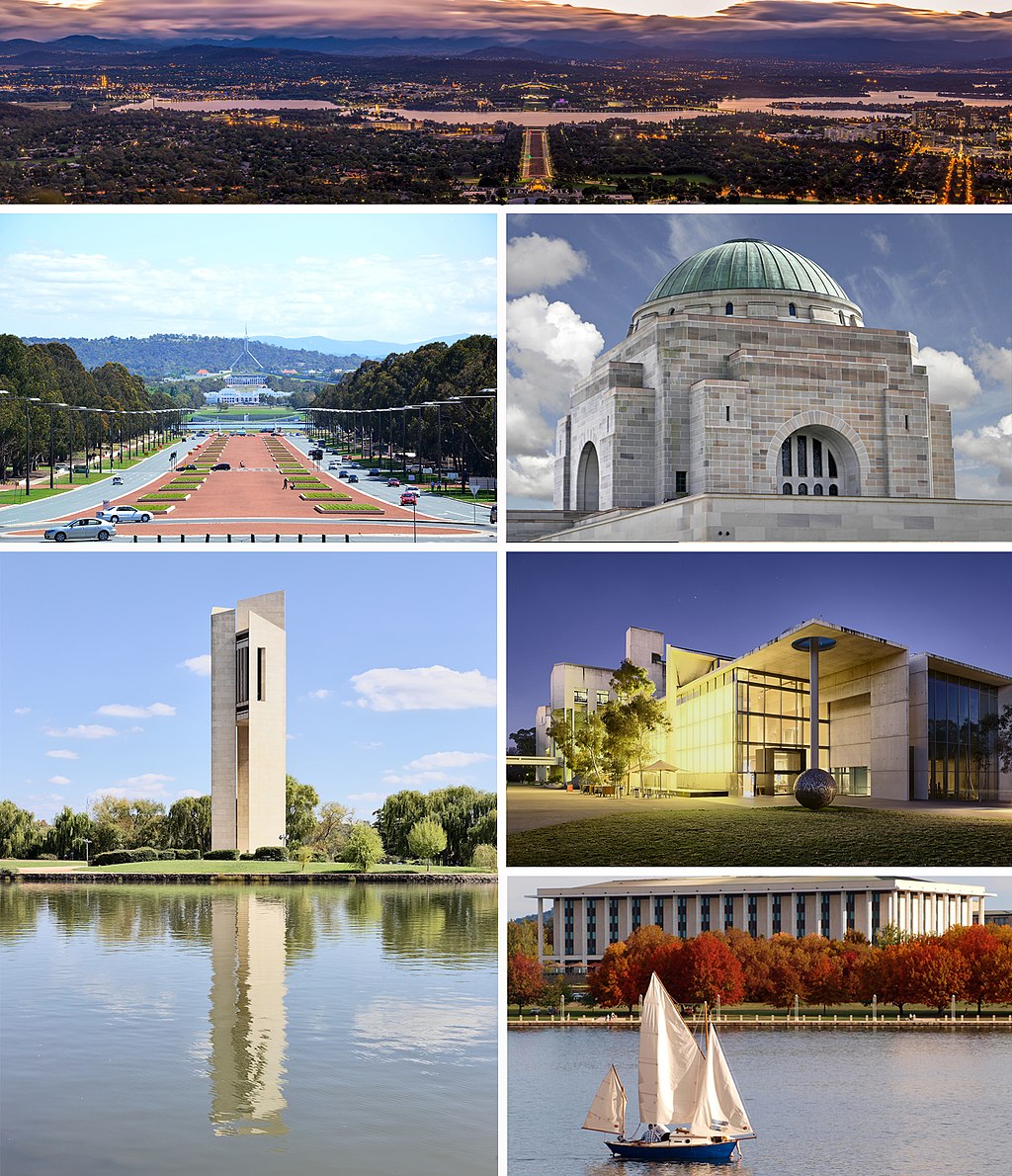
Canberra photos from top to bottom, left to right: Panorama of the city from Mount Ainslie, land axis with the old and the new parliament, Australian War Memorial, National Carillon, National Gallery of Australia, Lake Burley Griffin with the National Library of Australia. Ashton 29, CC BY-SA 4.0, via Wikimedia Commons
Cairns (North west Australia – Queensland)
In northern Queensland, on the way to Cape York, Cairns was founded in the late 19th century. The city has long remained ignored by tourists, which is no longer the case today. Retaining its tropical colonial charm, Cairns has still kept an idyllic setting. Many colonial-era buildings remain in downtown Cairns, surrounded by green hills.
Highlights:
- Starting point for the Great Barrier Reef
- Tropical region
- Many excursions and national parks to do in the region
Due to its proximity to many attractions, Cairns has become a popular destination for foreign tourists and is considered by many backpackers to be the top destination in Australia.

You can do snorkeling in the Great Barrier Reef, Australia. Dmitry Brant, CC BY-SA 4.0, via Wikimedia Commons
The Great Barrier Reef (World Heritage Site) can be reached in an hour and a half by speedboat. Green Island and Fitzroy Island National Park are popular yachting destinations. The Daintree National Park in the north offers visitors a tropical rainforest experience.
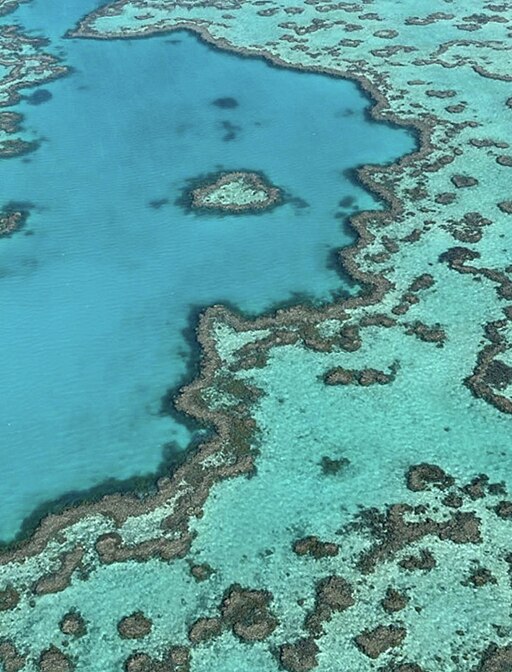
Heart Reef and Lagoon in the Whitsundays Queensland. Alphasauce, CC BY-SA 4.0, via Wikimedia Commons
Darwin
Capital of the Northern Territory, Darwin is a stopover town. Located on the coast, it provides access to the region’s coastline, but especially to national parks and southern territories. A modern city, Darwin is dynamic and lively, bathed in a cosmopolitan atmosphere. Its historic center is home to old buildings, its beaches are superb.
Read also: Darwin and Surroundings (Northern Territory Australia) | Complete Travel Guide
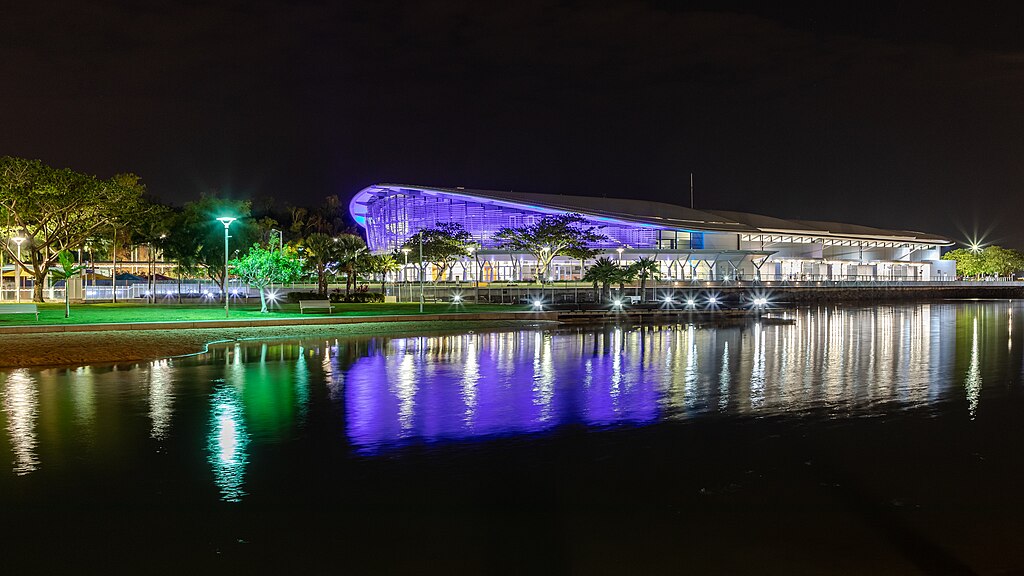
Darwin Waterfront and Convention centre, Darwin, Northern Territory, Australia. Dietmar Rabich / Wikimedia Commons / /
Gold Coast (West Australia, Queensland)
South of Brisbane, the Gold Coast stretches over 35 km long beaches and seaside resorts. It is the most touristic coast of the country, which receives more than 2 million visitors a year. Formerly a resort, it was transformed into a gigantic tourist reservoir after the Second World War. Passing through the Gold Coast, you can visit Sea World, an aquatic amusement park, or the Currumbien Sanctuary where you can observe many animal species.
Tourist attractions include surf beaches and theme parks including, Dreamworld, Sea World, Wet’n’Wild, Seaworld, Warner Bros Movie World, WhiteWater World, Currumbin Wildlife Sanctuary, David Fleay Wildlife Park, Australian Outback Spectacular and Paradise Country.
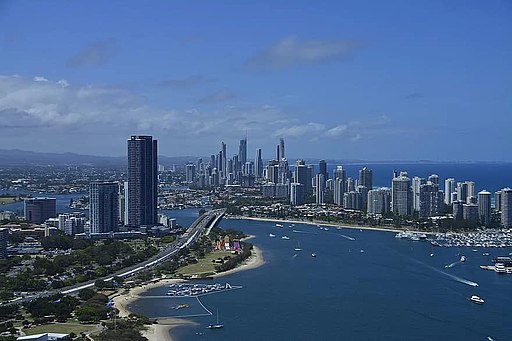
Gold coast skyline. Cement4802, CC0, via Wikimedia Commons
Hobart
The capital of Tasmania is not lacking in charm. Hobart has something of the small provincial town of England with its 1900 Georgian buildings. The port, which became famous thanks to the famous Sydney-Hobart regatta, is the ideal place to contemplate the Derwent River while eating a fish & chips. Situated at the mouth of the Derwent, Hobart is surrounded by Mounts Wellington and Nelson.
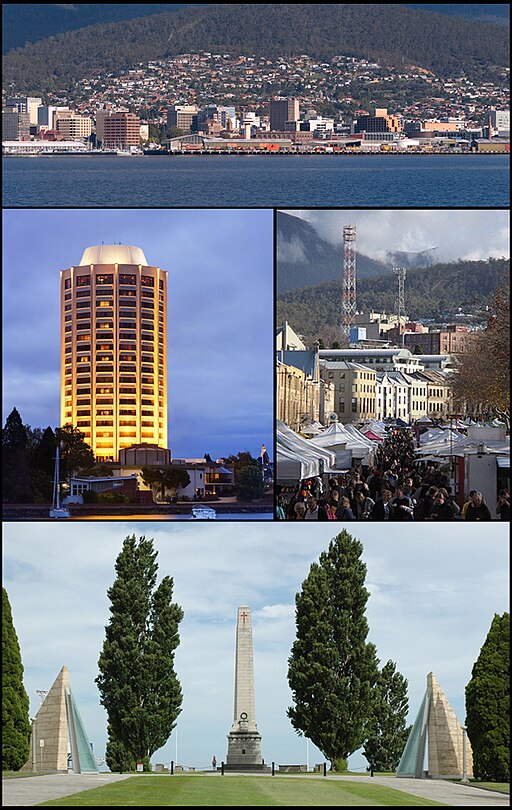
Hobart CBD, Wrest Point Hotel Casino, Salamanca Place, Hobart Cenotaph. w:User:Anoldtreeok, CC BY-SA 3.0, via Wikimedia Commons
Melbourne
A typically Australian city and yet so different from other major cities in the country! Melbourne is the awakening of the senses, an invitation to travel and escape, between atypical architecture, art galleries, street art walks, gourmet restaurants and trendy shops.
The capital of Victoria is an inexhaustible reservoir of activities and pleasures. For example, take part in a party or outdoor event in Federation Square, stroll through one of the city’s many parks and gardens, browse the Queen Victoria Market among the stalls of 600 fruit, fish and organic produce merchants… or watch the Penguin Parade on St Kilda Beach. Without forgetting to taste an espresso served by the best baristas in the country!
Plan at least 5 days there to capture all the grandeur, charm and all the assets of Australia’s second largest city. Melbourne, we love it!
Time zone: AEST (UTC+10)
Summer (DST): AEDT (UTC+11)
The strong points:
- The second fastest growing city in Australia
- The architectural style of the city is very European
- Many cultural events throughout the year
- The beauty of the city thanks to its Victorian architecture and art buildings and decorations
- Important street art culture
- Very cosmopolitan population
- Vibrant nightlife
- Ease of movement thanks to good cycling facilities

(From top left to bottom right) Melbourne City Centre, Flinders Street Station, Shrine of Remembrance, Federation Square, Melbourne Cricket Ground, Royal Exhibition Building. Montage by HappyWaldo., CC BY-SA 3.0, via Wikimedia Commons
Perth
On the banks of the Swan River, Perth is a modern and dynamic city. Founded in 1829, located more than 4,000 km from Sydney, it is said to be the most isolated metropolis in the world. The skyscrapers of the City rub shoulders with old buildings of the 1900 style. Perth is a really very pleasant city, with its huge park and the coolness of the surrounding hills.

From above, left to right: Perth skyline as seen from South Perth, Perth Mint, Elizabeth Quay bridge, Swan Bell Tower, His Majesty’s Theatre, Kings Park State War Memorial. AwMan12334, CC BY 3.0, via Wikimedia Commons
Highlights:
- Fairly dynamic medium-sized city
- Pedestrian town center with a few shops and shopping malls
- Many beaches nearby
- Pleasant temperatures all year round (Mediterranean climate)
- Starting point for visiting the West Coast
Sydney
Sydney, set on a beautiful bay, is Australia’s oldest city and a major port. Founded at the end of the 19th century by European settlers, today it is the most populous city in the country. Sydney has succeeded in leaping into the 21st century while keeping an old charm.
Sydney Opera House | Prices, Opening Hours, Ticket Reservations
The Sydney Opera House, an ultramodern construction and symbol of Australia, stands alongside the historic Rocks district, while the Harbor Bridge spans the bay. Sydney leads a vibrant life, to which the various ethnic communities contribute. It also has many beaches, which gives it a good quality of life.
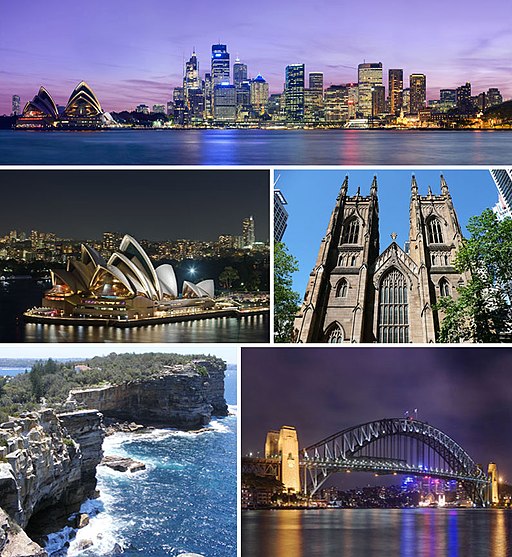
Sydney Central Business District, Sydney Opera House, St. Andrew, Sydney Harbor Bridge. Ashton 29, CC BY-SA 4.0, via Wikimedia Commons
Strong points:
- Many points of interest (Opera, Harbor Bridge, legendary beaches, etc.)
- Very dynamic city and efficient transport network
- Many parks and beaches
- Important surf culture
- Lively nightlife
What are your plans once you arrive?
Stay in town
For those who wish to settle for a few weeks or months in a major Australian city, we recommend that you take a good look at the advantages of each of them. The more “urban” will naturally choose the cities of Sydney, Melbourne, Brisbane or Perth. Depending on the sector in which you want to work, certain cities will be more suitable. Also think about the cost of living and the quality of life that each of these cities offers. If you are very beach or very surfing for example, there is no need to go to Cairns or Brisbane.
Find a job quickly
If you want to work in Fruit Picking, it is essential to consult the harvest calendar in order to arrive at the right place at the right time. It is also recommended to arrive two weeks before the start of the harvest in order to do your first administrative procedures, find a vehicle and start applying to farms.
If you want to work in town, you can arrive in the one of your choice. There will always be jobs available. We advise you to avoid Sydney or Brisbane during high seasons because there is a lot of competition (not to mention Australian students who are on vacation). But these big cities are also the ones that offer the most opportunities. Cities like Adelaide or Perth can be a good idea to start! There will be many job offers and often these cities are shunned by backpackers (especially Adelaide).
Go on a Road Trip
Do you prefer to buy or rent a vehicle to travel in Australia? If you choose to buy, vans will be more expensive if you arrive in Sydney during high season (between October and January)! And yes, it is the famous rule of supply and demand. There are a lot of potential buyers, so the prices are going up! On the other hand, if you arrive in June, you can do very good business! On the other hand, if you arrive in a smaller city or out of season, the choices will be limited.
If you want to rent a vehicle, then think about doing it in advance. So you can benefit from better rates and have more choice as to the type of vehicles etc.
Travel Guide By Destination : Africa, Americas, Asia, Australia, Europe, Middle East
Sources: PinterPandai, Nomadic Matt’s Travel Site, Rough Guides, Tourism Australia
Photo credit (main picture): Brett Stanley (CC BY-SA 4.0) via Wikimedia Commons
Main photo description: the orange glow of Uluru (Ayer Rock) in the Northern Territory Australia
